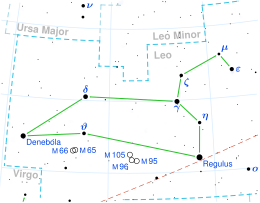Gamma Leonis
| Observation data Epoch J2000 Equinox J2000 | |
|---|---|
| Constellation | Leo |
| Right ascension | 10h 19m 58.35056s[1] |
| Declination | +19° 50′ 29.3468″[1] |
| Apparent magnitude (V) | 2.08 (2.37/3.64)[2] |
| Characteristics | |
| Evolutionary stage | Red clump (both stars)[3] |
| Spectral type | K0III + G7III[3] |
| U−B color index | 1.00 |
| B−V color index | 1.14 |
| Variable type | RS CVn[4] |
| Absolute magnitude (MV) | −0.27/+0.98[6] |
| Details Gyr | |
HR 4058, SAO 81299 | |
| Position (relative to A)[2] | |
| Component | B |
″ | |
| Database references | |
Exoplanet Archive | data |
Gamma Leonis (γ Leonis, abbreviated Gamma Leo, γ Leo), also named Algieba /ælˈdʒiːbə/,[8][9] is a binary star system in the constellation of Leo, made up of two red giants. In 2009, a planetary companion around the primary was announced.
Nomenclature
γ Leonis (Latinised to Gamma Leonis) is the star's Bayer designation. The A and B components of the binary are often referred to as γ1 Leonis and γ2 Leonis, respectively.
It also bore the traditional name Algieba or Al Gieba, which originated from the
The star's traditional Latin name was Juba. It is known as 軒轅十二 (the Twelfth Star of Xuanyuan) in Chinese (Xuanyuan is the name of the Yellow Emperor).[citation needed]
Algieba, along with Zeta Leonis, Regulus, Mu Leonis, Epsilon Leonis and Eta Leonis, have collectively been called the Sickle, which is an asterism that marks the head of Leo.[12]
Stellar system

The bright binary system in Leo with orange-red and yellow or greenish-yellow components is visible through a modest telescope under good atmospheric conditions. To the naked eye, the Algieba system shines at mid-second magnitude, but a telescope easily splits the pair. The double nature of Gamma Leonis was discovered by William Herschel in 1992.[7]
The brighter component (named Gamma1 Leonis) has an
The orbital parameters of Gamma Leonis are still uncertain due to the very long orbit. The
Variability
γ Leonis was a suspected variable star, with a
The flare star AD Leonis lies just 5' from γ Leonis.[14] It is unrelated to the pair,[16] and much closer to Earth at a distance of 4.97 parsecs (16.2 ly).[17]
Planetary system
On November 6, 2009, the discovery of a planetary companion around primary star γ1 Leonis (γ Leonis A) was announced.[7] The radial velocity measurements suggest two additional periodicities of 8.5 and 1,340 days. The former is likely due to stellar pulsation, whereas the latter could be indicative of the presence of an additional planetary companion with 2.14 Jupiter masses, moderate eccentricity (e=0.13) and located at 2.6 AU away from the giant star. Nevertheless, the nature of such a signal is still unclear and further investigations are needed to confirm or rule out an additional substellar companion.
A new study revised the minimum mass for Gamma1 Leonis b to about 10.7 MJ (increased by 20%),[a] based on a larger mass for the host star (1.66 M☉ intsead of 1.23 M☉).[3]
| Companion (in order from star) |
Mass | Semimajor axis (AU) |
Orbital period (days) |
Eccentricity | Inclination | Radius |
|---|---|---|---|---|---|---|
| b | ≥10.7 MJ | 1.19 | 429 | 0.14 | — | — |
| c (unconfirmed) | ≥2.14 MJ | 2.6 | 1,340 | 0.13 | — | — |
Notes
- ^ The previous mass estimate was 8.78 MJ.
- ^ The orbital parameters are still subject to uncertainites and should be viewed with caution.
References
- ^ S2CID 18759600.
- ^ .
- ^ ISSN 0004-640X.
- ^ AAVSO. Retrieved 2024-06-14.
- S2CID 17804304
- doi:10.1086/191527
- ^ S2CID 118962986.
- ISBN 978-1-931559-44-7.
- ^ "IAU Catalog of Star Names". Retrieved 28 July 2016.
- ^ "IAU Working Group on Star Names (WGSN)". Retrieved 22 May 2016.
- ^ "Bulletin of the IAU Working Group on Star Names, No. 1" (PDF). Retrieved 28 July 2016.
- ^ Proctor, Mary (July 1896), "Evenings with the Stars", Popular Astronomy, 4: 565
- Bibcode:2009yCat....102025S.
- ^ Bibcode:1995yCat.5050....0H..
{{cite journal}}: CS1 maint: multiple names: authors list (link) Gamma Leonis' database entry at VizieR - doi:10.1086/107936.
- ^ Cite error: The named reference
wdswas invoked but never defined (see the help page). - S2CID 244398875. Gaia DR3 record for this source at VizieR.
External links
- Algieba at Jim Kaler's Stars
- Astronomical Reference from Author David Darling

